Pre-Columbian era

| Human history | |||
|---|---|---|---|
| ↑ Prehistory | |||
| Recorded history | |||
| Ancient | |||
| Postclassical | |||
| Modern | |||
|
|||
| ↓ Future | |||
The Pre-Columbian era incorporates all period subdivisions in the history and prehistory of the Americas before the appearance of significant European influences on the American continents, spanning the time of the original settlement in the Upper Paleolithic period to European colonization during the Early Modern period.
While the phrase "pre-Columbian era" literally refers only to the time preceding Christopher Columbus's voyages of 1492, in practice the phrase is usually used to denote the entire history of indigenous Americas cultures until those cultures were vanquished, diminished, or extensively altered by Europeans, even if this happened decades or centuries after Columbus's first landing. For this reason the alternative terms of Precontact Americas, Pre-Colonial Americas or Prehistoric Americas are also in use. In areas of Latin America the term usually used is Pre-Hispanic. Similarly, the Norse colonization of North America is generally not treated as "pre-Columbian", despite the fact that it predates Columbus by several centuries.
Many pre-Columbian civilizations established hallmarks which included permanent settlements, cities, agriculture, civic and monumental architecture, major earthworks, and complex societal hierarchies. Some of these civilizations had long faded by the time of the first permanent European colonies and the arrival of enslaved Africans (c. late 16th–early 17th centuries),[1] and are known only through archaeological investigations and oral history. Other civilizations were contemporary with the colonial period and were described in European historical accounts of the time. A few, such as the Maya civilization, had their own written records. Because many Christian Europeans of the time viewed such texts as heretical, men like Diego de Landa destroyed many texts in pyres, even while seeking to preserve native histories. Only a few hidden documents have survived in their original languages, while others were transcribed or dictated into Spanish, giving modern historians glimpses of ancient culture and knowledge.
Indigenous American cultures continue to evolve after the pre-Columbian era. Many of these peoples and their descendants continue traditional practices, while evolving and adapting new cultural practices and technologies into their lives.
History
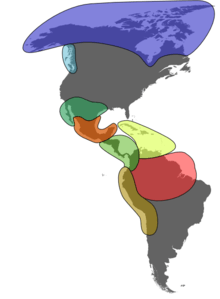
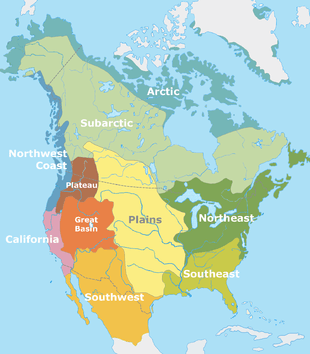
Before the development of archaeology in the 19th century, historians of the pre-Columbian period mainly interpreted the records of the European conquerors and the accounts of early European travellers and antiquaries. It was not until the nineteenth century that the work of men such as John Lloyd Stephens, Eduard Seler and Alfred P. Maudslay, and of institutions such as the Peabody Museum of Harvard University, led to the reconsideration and criticism of the European sources. Now, the scholarly study of pre-Columbian cultures is most often based on scientific and multidisciplinary methodologies.[2]
Settlement of the Americas
Asian nomads are thought to have entered the Americas via the Bering Land Bridge (Beringia), now the Bering Strait and possibly along the coast. Genetic evidence found in Amerindians' maternally inherited mitochondrial DNA (mtDNA) supports the theory of multiple genetic populations migrating from Asia.[3][4] Over the course of millennia, Paleo-Indians spread throughout North and South America. Exactly when the first group of people migrated into the Americas is the subject of much debate. One of the earliest identifiable cultures was the Clovis culture, with sites dating from some 13,000 years ago. However, older sites dating back to 20,000 years ago have been claimed. Some genetic studies estimate the colonization of the Americas dates from between 40,000 and 13,000 years ago.[5] The chronology of migration models is currently divided into two general approaches. The first is the short chronology theory with the first movement beyond Alaska into the New World occurring no earlier than 14,000–17,000 years ago, followed by successive waves of immigrants.[6][7][8][9] The second belief is the long chronology theory, which proposes that the first group of people entered the hemisphere at a much earlier date, possibly 50,000–40,000 years ago or earlier.[10][11][12][13]
Artifacts have been found in both North and South America which have been dated to 14,000 years ago,[14] and accordingly humans have been proposed to have reached Cape Horn at the southern tip of South America by this time. In that case, the Eskimo peoples would have arrived separately and at a much later date, probably no more than 2,000 years ago, moving across the ice from Siberia into Alaska.
North America
Archaic period
The North American climate was unstable as the ice age receded. It finally stabilized by about 10,000 years ago; climatic conditions were then very similar to today's.[15] Within this timeframe, roughly pertaining to the Archaic Period, numerous archaeological cultures have been identified.
The unstable climate led to widespread migration, with early Paleo-Indians soon spreading throughout the Americas, diversifying into many hundreds of culturally distinct tribes.[16] The paleo-indians were hunter-gatherers, likely characterized by small, mobile bands consisting of approximately 20 to 50 members of an extended family. These groups moved from place to place as preferred resources were depleted and new supplies were sought.[17] During much of the Paleo-Indian period, bands are thought to have subsisted primarily through hunting now-extinct giant land animals such as mastodon and ancient bison.[18] Paleo-Indian groups carried a variety of tools. These included distinctive projectile points and knives, as well as less distinctive implements used for butchering and hide processing.
The vastness of the American continent, and the variety of its climates, ecology, vegetation, fauna, and landforms, led ancient peoples to coalesce into many distinct linguistic and cultural groups.[19] This is reflected in the oral histories of the indigenous peoples, described by a wide range of traditional creation stories which often say that a given people has been living in a certain territory since the creation of the world.
Over the course of thousands of years, paleo-indian people domesticated, bred and cultivated a number of plant species. These species were very nutritious, and they now constitute 50–60% of all crops in cultivation worldwide.[20] In general, Arctic, Subarctic, and coastal peoples continued to live as hunters and gatherers, while agriculture was adopted in more temperate and sheltered regions. But wherever it was adopted, plant cultivation permitted a dramatic rise in population.[15]
Middle Archaic period
After the migration or migrations, it was several thousand years before the first complex societies arose, the earliest emerging about seven to eight thousand years ago. As early as 6500 BCE, people in the Lower Mississippi Valley at the Monte Sano site were building complex earthwork mounds, probably for religious purposes. This is the earliest dated of numerous mound complexes found in present-day Louisiana, Mississippi and Florida. Since the late twentieth century, archeologists have explored and dated these sites. They have found that they were built by hunter-gatherer societies, whose people occupied the sites on a seasonal basis, and who had not yet developed ceramics. Watson Brake, a large complex of eleven platform mounds, was constructed beginning in 3400 BCE and added to over 500 years. This has changed earlier assumptions that complex construction arose only after societies had adopted agriculture, become sedentary, often developed stratified hierarchy, and generally also developed ceramics. These ancient people had organized to build complex mound projects from a different basis.
Late Archaic period

Until the accurate dating of Watson Brake and similar sites, the oldest mound complex was thought to be Poverty Point, also located in the Lower Mississippi Valley. Built about 1500 BCE, it is the centerpiece of a culture extending over 100 sites on both sides of the Mississippi. The Poverty Point site has earthworks in the form of six concentric half-circles, divided by radial aisles, together with some mounds. The entire complex is nearly a mile across.
Mound building was continued by succeeding cultures, who built numerous sites in the middle Mississippi and Ohio River valleys as well, adding effigy mounds, conical and ridge mounds and other shapes.
Woodland period
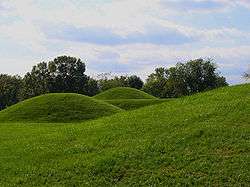
The Woodland period of North American pre-Columbian cultures refers to the time period from roughly 1000 BCE to 1000 CE in the eastern part of North America. The term "Woodland" was coined in the 1930s and refers to prehistoric sites between the Archaic period and the Mississippian cultures. The Adena culture and the ensuing Hopewell tradition during this period built monumental earthwork architecture and established continent-spanning trade and exchange networks.
This period is considered a developmental stage without any massive changes in a short period, but instead having a continuous development in stone and bone tools, leather working, textile manufacture, tool production, cultivation, and shelter construction. Some Woodland peoples continued to use spears and atlatls until the end of the period, when they were replaced by bows and arrows.
Mississippian culture

The Mississippian culture was spread across the Southeast and Midwest from the Atlantic coast to the edge of the plains, from the Gulf of Mexico to the Upper Midwest, although most intensively in the area along the Mississippi River and Ohio River. One of the distinguishing features of this culture was the construction of complexes of large earthen mounds and grand plazas, continuing the moundbuilding traditions of earlier cultures. They grew maize and other crops intensively, participated in an extensive trade network, and had a complex stratified society. The Mississippians first appeared around 1000 CE, following and developing out of the less agriculturally intensive and less centralized Woodland period. The largest urban site of this people, Cahokia—located near modern East St. Louis, Illinois—may have reached a population of over 20,000. Other chiefdoms were constructed throughout the Southeast, and its trade networks reached to the Great Lakes and Gulf of Mexico. At its peak, between the 12th and 13th centuries, Cahokia was the most populous city in North America. (Larger cities did exist in Mesoamerica and South America.) Monk's Mound, the major ceremonial center of Cahokia, remains the largest earthen construction of the prehistoric New World. The culture reached its peak in about 1200-1400 C.E., and in most places, it seems to have been in decline before the arrival of Europeans.
Many Mississippian peoples were encountered by the expedition of Hernando de Soto in the 1540s, mostly with disastrous results for both sides. Unlike the Spanish expeditions in Mesoamerica, who conquered vast empires with relatively few men, the de Soto expedition wandered the American Southeast for four years, becoming more bedraggled, losing more men and equipment, and eventually arriving in Mexico as a fraction of its original size. The local people fared much worse though, as the fatalities of diseases introduced by the expedition devastated the populations and produced much social disruption. By the time Europeans returned a hundred years later, nearly all of the Mississippian groups had vanished, and vast swaths of their territory were virtually uninhabited.[21]
Historic tribes
When the Europeans arrived, indigenous peoples of North America had a wide range of lifeways from sedentary, agrarian societies to semi-nomadic hunter-gatherer societies. Many formed new tribes or confederations in response to European colonization. These are often classified by cultural regions, loosely based on geography. These can include the following:
- Arctic, including Aleut, Inuit, and Yupik peoples
- Subarctic
- Northeastern Woodlands
- Southeastern Woodlands
- Great Plains
- Great Basin
- Northwest Plateau
- Northwest Coast
- California
- Southwest (Oasisamerica)
Numerous pre-Columbian societies were sedentary, such as the Pueblo peoples, Mandan, Hidatsa and others, and some established large settlements, even cities, such as Cahokia, in what is now Illinois. The Iroquois League of Nations or "People of the Long House" was a politically advanced, democratic society, which is thought by some historians to have influenced the United States Constitution,[22][23] with the Senate passing a resolution to this effect in 1988.[24] Other historians have contested this interpretation and believe the impact was minimal, or did not exist, pointing to numerous differences between the two systems and the ample precedents for the constitution in European political thought.[25][26][27]
Mesoamerica

Mesoamerica is the region extending from central Mexico south to the northwestern border of Costa Rica that gave rise to a group of stratified, culturally related agrarian civilizations spanning an approximately 3,000-year period before the visits to the New World by Christopher Columbus. Mesoamerican is the adjective generally used to refer to that group of pre-Columbian cultures. This refers to an environmental area occupied by an assortment of ancient cultures that shared religious beliefs, art, architecture, and technology in the Americas for more than three thousand years.
Between 2000 and 300 BCE, complex cultures began to form in Mesoamerica. Some matured into advanced pre-Columbian Mesoamerican civilizations such as the Olmec, Teotihuacan, Maya, Zapotec, Mixtec, Huastec, Purepecha, Toltec, and Mexica/Aztecs. The Mexica civilization is also known as the Aztec Triple Alliance, since they were three smaller kingdoms loosely united together[28].
These indigenous civilizations are credited with many inventions: building pyramid-temples, mathematics, astronomy, medicine, writing, highly accurate calendars, fine arts, intensive agriculture, engineering, an abacus calculator, and complex theology. They also invented the wheel, but it was used solely as a toy. In addition, they used native copper, silver and gold for metalworking, in which they used very advanced methods.
Archaic inscriptions on rocks and rock walls all over northern Mexico (especially in the state of Nuevo León) demonstrate an early propensity for counting. Their number system was base 20 and included zero. These early count-markings were associated with astronomical events and underscore the influence that astronomical activities had upon Mesoamerican people before the arrival of Europeans. Many of the later Mesoamerican civilizations carefully built their cities and ceremonial centers according to specific astronomical events.
The biggest Mesoamerican cities, such as Teotihuacan, Tenochtitlan, and Cholula, were among the largest in the world. These cities grew as centers of commerce, ideas, ceremonies, and theology, and they radiated influence outwards onto neighboring cultures in central Mexico.
While many city-states, kingdoms, and empires competed with one another for power and prestige, Mesoamerica can be said to have had five major civilizations: the Olmec, Teotihuacan, the Toltec, the Mexica and the Maya. These civilizations (with the exception of the politically fragmented Maya) extended their reach across Mesoamerica—and beyond—like no others. They consolidated power and distributed influence in matters of trade, art, politics, technology, and theology. Other regional power players made economic and political alliances with these civilizations over the span of 4,000 years. Many made war with them, but almost all peoples found themselves within one of their spheres of influence.
Regional communications in ancient Mesoamerica have been the subject of considerable research. There is evidence of trade routes starting as far north as the Mexico Central Plateau, and going down to the Pacific coast. These trade routes and cultural contacts then went on as far as Central America. These networks operated with various interruptions from pre-Olmec times and up to the Late Classical Period (600–900 CE).
Olmec civilization
The earliest known civilization is the Olmec. This civilization established the cultural blueprint by which all succeeding indigenous civilizations would follow in Mexico. Pre-Olmec civilization began with the production of pottery in abundance, around 2300 BCE in the Grijalva River delta. Between 1600 and 1500 BCE, the Olmec civilization had begun, with the consolidation of power at their capital, a site today known as San Lorenzo Tenochtitlán near the coast in southeast Veracruz.[29] The Olmec influence extended across Mexico, into Central America, and along the Gulf of Mexico. They transformed many peoples' thinking toward a new way of government, pyramid-temples, writing, astronomy, art, mathematics, economics, and religion. Their achievements paved the way for the greatness of the Maya civilization in the east and the civilizations to the west in central Mexico.
Teotihuacan civilization
The decline of the Olmec resulted in a power vacuum in Mexico. Emerging from that vacuum was Teotihuacan, first settled in 300 BCE. By 150 CE, Teotihuacan had risen to become the first true metropolis of what is now called North America. Teotihuacan established a new economic and political order never before seen in Mexico. Its influence stretched across Mexico into Central America, founding new dynasties in the Maya cities of Tikal, Copan, and Kaminaljuyú. Teotihuacan's influence over the Maya civilization cannot be overstated: it transformed political power, artistic depictions, and the nature of economics. Within the city of Teotihuacan was a diverse and cosmopolitan population. Most of the regional ethnicities of Mexico were represented in the city, such as Zapotecs from the Oaxaca region. They lived in apartment communities where they worked their trades and contributed to the city's economic and cultural prowess. Teotihuacan's economic pull impacted areas in northern Mexico as well. It was a city whose monumental architecture reflected a monumental new era in Mexican civilization, declining in political power about 650 CE—but lasting in cultural influence for the better part of a millennium, to around 950 CE.
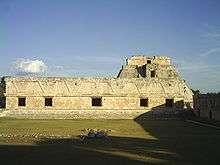
Maya civilization
Contemporary with Teotihuacan's greatness was that of the Maya civilization. The period between 250 CE and 650 CE was a time of intense flourishing of Maya civilized accomplishments. While the many Maya city-states never achieved political unity on the order of the central Mexican civilizations, they exerted a tremendous intellectual influence upon Mexico and Central America. The Maya built some of the most elaborate cities on the continent, and made innovations in mathematics, astronomy, and calendrics. The Mayans also evolved the only true writing system native to the Americas using pictographs and syllabic elements in the form of texts and codices inscribed on stone, pottery, wood, or highly perishable books made from bark paper.
Aztec/Mexica/Triple Alliance civilization
With the decline of the Toltec civilization came political fragmentation in the Valley of Mexico. Into this new political game of contenders to the Toltec throne stepped outsiders: the Mexica. They were also a desert people, one of seven groups who formerly called themselves "Azteca", in memory of Aztlán, but they changed their name after years of migrating. Since they were not from the Valley of Mexico, they were initially seen as crude and unrefined in the ways of Nahua civilization. Through political maneuvers and ferocious fighting skills, they managed to become the rulers of Mexico as the head of the 'Triple Alliance' (which included two other "Aztec" cities, Texcoco and Tlacopan).
Latecomers to Mexico's central plateau, the Mexica thought of themselves, nevertheless, as heirs of the civilizations that had preceded them. For them, arts, sculpture, architecture, engraving, feather-mosaic work, and the calendar, were bequest from the former inhabitants of Tula, the Toltecs.
The Mexica-Aztecs were the rulers of much of central Mexico by about 1400 (while Yaquis, Coras and Apaches commanded sizable regions of northern desert), having subjugated most of the other regional states by the 1470s. At their peak, 300,000 Mexica presided over a wealthy tribute-empire variously estimated at 5-8 million people in total a population of 8-12 millions. The actual population is never more than an estimate. The modern name "Mexico" comes from their name.
Their capital, Tenochtitlan, is the site of modern-day capital of Mexico, Mexico City. At its peak, it was one of the largest cities in the world with population estimates of 200-300,000.[30] The market established there was the largest ever seen by the conquistadors on arrival.
South America

By the first millennium, South America's vast rainforests, mountains, plains, and coasts were the home of millions of people. Estimates vary, but 30-50 million are often given and 100 million by some estimates. Some groups formed permanent settlements. Among those groups were Chibcha-speaking peoples ("Muisca" or "Muysca"), Valdivia, Quimbaya, Calima and the Tairona. The Muisca of Colombia, postdating the Herrera Period, Valdivia of Ecuador, the Quechuas and the Aymara of Peru and Bolivia were the four most important sedentary Amerindian groups in South America. From the 1970s, numerous geoglyphs have been discovered on deforested land in the Amazon rainforest, Brazil, supporting Spanish accounts of a complex, possibly ancient Amazonian civilization.[31][32]
The theory of pre-Columbian contact across the South Pacific Ocean between South America and Polynesia has received support from several lines of evidence, although solid confirmation remains elusive. A diffusion by human agents has been put forward to explain the pre-Columbian presence in Oceania of several cultivated plant species native to South America, such as the bottle gourd (Lagenaria siceraria) or sweet potato (Ipomoea batatas). Direct archaeological evidence for such pre-Columbian contacts and transport have not emerged. Similarities noted in names of edible roots in Maori and Ecuadorian languages ("kumari") and Melanesian and Chilean ("gaddu") have been inconclusive.[33]
A 2007 paper published in PNAS put forward DNA and archaeological evidence that domesticated chickens had been introduced into South America via Polynesia by late pre-Columbian times.[34] These findings were challenged by a later study published in the same journal, that cast doubt on the dating calibration used and presented alternative mtDNA analyses that disagreed with a Polynesian genetic origin.[35] The origin and dating remains an open issue. Whether or not early Polynesian–American exchanges occurred, no compelling human-genetic, archaeological, cultural or linguistic legacy of such contact has turned up.
Norte Chico or Caral
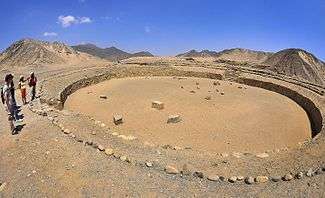
On the north-central coast of present-day Peru, Norte Chico or Caral (as known in Peru) was a civilization that emerged around 3000 BCE (contemporary with urbanism's rise in Mesopotamia.) It is considered one of the six cradles of civilization in the world.[36] It had a cluster of large-scale urban settlements of which the Sacred City of Caral, in the Supe valley, is one of the largest and best studied sites. Norte Chico or Caral is the oldest known civilization in the Americas and persisted until around 1800 BCE.
Valdivia
The Valdivia culture was concentrated on the coast of Ecuador. Their existence was recently discovered by archeological findings. Their culture is among the oldest found in the Americas, spanning from 3500 to 1800 BCE. The Valdivia lived in a community of houses built in a circle or oval around a central plaza. They were sedentary people who lived off farming and fishing, though occasionally they hunted for deer. From the remains that have been found, scholars have determined that Valdivians cultivated maize, kidney beans, squash, cassava, hot peppers, and cotton plants, the last of which was used to make clothing. Valdivian pottery initially was rough and practical, but it became showy, delicate, and big over time. They generally used red and gray colors; and the polished dark red pottery is characteristic of the Valdivia period. In its ceramics and stone works, the Valdivia culture shows a progression from the most simple to much more complicated works.
Cañaris
The Cañari were the indigenous natives of today's Ecuadorian provinces of Cañar and Azuay. They were an elaborate civilization with advanced architecture and complex religious beliefs. The Inca destroyed and burned most of their remains. The Cañari's old city was replaced twice, first by the Incan city of Tumebamba and later on the same site by the colonial city of Cuenca. The city was also believed to be the site of El Dorado, the city of gold from the mythology of Colombia. (see Cuenca)
The Cañari were most notable for having repelled the Incan invasion with fierce resistance for many years until they fell to Tupac Yupanqui. Many of their descendants are still present in Cañar. The majority did not mix with the colonists or become Mestizos.
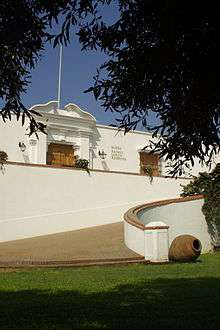
Chavín
The Chavín, a South American preliterate civilization, established a trade network and developed agriculture by 900 BCE, according to some estimates and archeological finds. Artifacts were found at a site called Chavín in modern Peru at an elevation of 3,177 meters. The Chavín civilization spanned from 900 to 300 BCE.
Muisca
The Chibcha-speaking communities were the most numerous, the most territorially extended and the most socio-economically developed of the pre-Hispanic Colombians. By the 8th century, the indigenous people had established their civilization in the northern Andes. At one point, the Chibchas occupied part of what is now Panama, and the high plains of the Eastern Sierra of Colombia.
The areas which they occupied in Colombia were the present-day Departments of Santander (North and South), Boyacá and Cundinamarca. This is where the first farms and industries were developed. It is also where the independence movement originated. They are currently the richest areas in Colombia. The Chibcha developed the most populous zone between the Mayan and Inca empires. Next to the Quechua of Peru and the Aymara in Bolivia, the Chibcha of the eastern and north-eastern Highlands of Colombia developed the most notable culture among the sedentary indigenous peoples in South America.
In the Colombian Andes, the Chibcha comprised several tribes who spoke similar languages (Chibcha). They included the following: the Muisca, Guane, Lache, Cofán, and Chitareros.
Moche
The Moche thrived on the north coast of Peru from about 100 to 800 CE. The heritage of the Moche is seen in their elaborate burials. Some were recently excavated by UCLA's Christopher B. Donnan in association with the National Geographic Society.
As skilled artisans, the Moche were a technologically advanced people. They traded with distant peoples such as the Maya. What has been learned about the Moche is based on study of their ceramic pottery; the carvings reveal details of their daily lives. The Larco Museum of Lima, Peru has an extensive collection of such ceramics. They show that the people practiced human sacrifice, had blood-drinking rituals, and that their religion incorporated non-procreative sexual practices (such as fellatio).
Tiwanaku empire
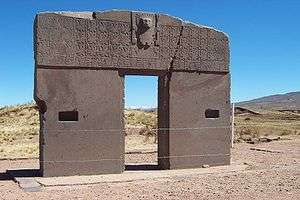
The Tiwanaku empire was based in western Bolivia and extended into present-day Peru and Chile from 300 to 1000. Tiwanaku is recognized by Andean scholars as one of the most important South American civilizations prior to the Inca Empire; it was the ritual and administrative capital of a major state power for approximately five hundred years. The ruins of the ancient city state are near the south-eastern shore of Lake Titicaca in Tiwanaku Municipality, Ingavi Province, La Paz Department, about 72 km (45 mi) west of La Paz.
Inca Empire
Holding their capital at the great cougar-shaped city of Cuzco, the Inca civilization dominated the Andes region from 1438 to 1533. Known as Tawantinsuyu, or "the land of the four regions", in Quechua, the Inca civilization was highly distinct and developed. Inca rule extended to nearly a hundred linguistic or ethnic communities, some 9 to 14 million people connected by a 40,000 kilometer road system. Cities were built with precise stonework, constructed over many levels of mountain terrain. Terrace farming was a useful form of agriculture. There is evidence of excellent metalwork and even successful brain surgery in Inca civilization.
Cambeba
Also known as the Omagua, Umana and Kambeba, the Cambeba are an indigenous people in Brazil's Amazon basin. The Cambeba were a populous, organized society in the late Pre-Columbian era whose population suffered steep decline in the early years of the Columbian Exchange. The Spanish explorer Francisco de Orellana traversed the Amazon River during the 16th century and reported densely populated regions running hundreds of kilometers along the river. These populations left no lasting monuments, possibly because they used local wood as their construction material as stone was not locally available. While it is possible Orellana may have exaggerated the level of development among the Amazonians, their semi-nomadic descendants have the odd distinction among tribal indigenous societies of a hereditary, yet landless, aristocracy. Archaeological evidence has revealed the continued presence of semi-domesticated orchards, as well as vast areas of land enriched with terra preta. Both of these discoveries, along with Cambeba ceramics discovered within the same archaeological levels suggest that a large and organized civilization existed in the area.[37]
Agricultural development
Early inhabitants of the Americas developed agriculture, developing and breeding maize (corn) from ears 2–5 cm in length to the current size are familiar today. Potatoes, tomatoes, tomatillos (a husked green tomato), pumpkins, chili peppers, squash, beans, pineapple, sweet potatoes, the grains quinoa and amaranth, cocoa beans, vanilla, onion, peanuts, strawberries, raspberries, blueberries, blackberries, papaya, and avocados were among other plants grown by natives. Over two-thirds of all types of food crops grown worldwide are native to the Americas.
The natives began using fire in a widespread manner. Intentional burning of vegetation was taken up to mimic the effects of natural fires that tended to clear forest understories, thereby making travel easier and facilitating the growth of herbs and berry-producing plants that were important for both food and medicines. This created the Pre-Columbian savannas of North America.[38]
While not as widespread as in other areas of the world (Asia, Africa, Europe), indigenous Americans did have livestock. Domesticated turkeys were common in Mesoamerica and in some regions of North America; they were valued for their meat, feathers, and, possibly, eggs. There is documentation of Mesoamericans utilizing hairless dogs, especially the Xoloitzcuintle breed, for their meat. Andean societies had llamas and alpacas for meat and wool, as well as for beasts of burden. Guinea pigs were raised for meat in the Andes. Iguanas and a range of wild animals, such as deer and pecari, were another source of meat in Mexico, Central, and northern South America.
By the 15th century, maize had been transmitted from Mexico and was being farmed in the Mississippi embayment, as far as the East Coast of the United States, and as far north as southern Canada. Potatoes were utilized by the Inca, and chocolate was used by the Aztecs.
Genetics

The haplogroup most commonly associated with Indigenous Amerindian genetics is Haplogroup Q1a3a (Y-DNA).[39] Y-DNA, like mtDNA, differs from other nuclear chromosomes in that the majority of the Y chromosome is unique and does not recombine during meiosis. This has the effect that the historical pattern of mutations can easily be studied.[40] The pattern indicates Indigenous Amerindians experienced two very distinctive genetic episodes; first with the initial-peopling of the Americas, and secondly with European colonization of the Americas.[41][42] The former is the determinant factor for the number of gene lineages and founding haplotypes present in today's Indigenous Amerindian populations.[42]
Human settlement of the New World occurred in stages from the Bering sea coast line, with an initial 20,000-year layover on Beringia for the founding population.[43][44] The micro-satellite diversity and distributions of the Y lineage specific to South America indicates that certain Amerindian populations have been isolated since the initial colonization of the region.[45] The Na-Dené, Inuit and Indigenous Alaskan populations exhibit haplogroup Q-M242 (Y-DNA) mutations, however are distinct from other indigenous Amerindians with various mtDNA mutations.[46][47][48] This suggests that the earliest migrants into the northern extremes of North America and Greenland derived from later populations.[49]
See also
- List of pre-Columbian cultures
- Metallurgy in pre-Columbian America
- Pre-Inca cultures in Peru
- Pre-Columbian trans-oceanic contact
- Pre-Columbian population
- 1491: New Revelations of the Americas Before Columbus
References
- ↑ "Early European Settlements in North America". Tripline. Retrieved 2017-05-06.
- ↑ Ignition Bernal, A History of Mexican Archaeology: The Vanished Civilizations of Middle America.
- ↑ Study confirms Bering land bridge flooded later than previously believed Cyberwest online, July 1996
- ↑ Bering Land Bridge US National Park System
- ↑ Wells, Spencer; Read, Mark (2002). The Journey of Man - A Genetic Odyssey (Digitised online by Google books). Random House. pp. 138–140. ISBN 0-8129-7146-9. Retrieved 2009-11-21.
- ↑ "Americas Settled 15,000 Years Ago, Study Says". National Geographic News. March 13, 2008. Retrieved 2011-06-04.
- ↑ "First Americans". Southern Methodist University-David J. Meltzer, B.A., M.A., Ph.D.
- ↑ Fagundes, Nelson J.R.; Ricardo Kanitz, Roberta Eckert, Ana C.S. Valls, Mauricio R. Bogo, Francisco M. Salzano, David Glenn Smith, Wilson A. Silva, Marco A. Zago, Andrea K. Ribeiro-dos-Santos, Sidney E.B. Santos, Maria Luiza Petzl-Erler, and Sandro L.Bonatto (2008). "Mitochondrial Population Genomics Supports a Single Pre-Clovis Origin with a Coastal Route for the Peopling of the Americas". American Journal of Human Genetics. 82 (3): 583–592. PMC 2427228
 . PMID 18313026. doi:10.1016/j.ajhg.2007.11.013.
. PMID 18313026. doi:10.1016/j.ajhg.2007.11.013. - ↑ "Beginnings to 1500 C.E.". Encyclopedia of Canada's Peoples.
- ↑ "Atlas of the Human Journey". National Genographic.
- ↑ Marder, William (April 2005). Indians in the Americas: the untold story. By William Marder. ISBN 978-1-58509-104-1. Retrieved 2009-11-17.
- ↑ "Journey of mankind". Brad Shaw Foundation.
- ↑ Gibbon, Guy E; Ames, Kenneth M (1998). Archaeology of prehistoric native America: an encyclopedia. Guy E. Gibbon, Kenneth M. Ames. ISBN 978-0-8153-0725-9. Retrieved 2010-10-31.
- ↑ Noble, John (2008-04-04). "Evidence Supports Earlier Date for People in North America, NYT, April 4, 2008". Nytimes.com. Retrieved 2011-06-03.
- 1 2 J. Imbrie and K.P.Imbrie, Ice Ages: Solving the Mystery, (Short Hills, NJ: Enslow Publishers) 1979.
- ↑ Jacobs (2002).
- ↑ Kelly, Robert L.; Lawrence C. Todd (1988). "Coming into the Country: Early Paleo-Indian Hunting and Mobility". American Antiquity. 53 (2): 231–244. JSTOR 281017. doi:10.2307/281017.
- ↑ Breitburg, Emanual; John B. Broster; Arthur L. Reesman; Richard G. Strearns (1996). "Coats-Hines Site: Tennessee's First Paleo-Indian Mastodon Association". Current Research in the Pleistocene. 13: 6–8.
- ↑ Fagan, Brian M. People of the Earth: An Introduction to World Prehistory, University of California: Harper Collins, 1992.
- ↑ ""Native Americans: The First Farmers." ''AgExporter'' October 1, 1999". Allbusiness.com. Retrieved 2011-06-03.
- ↑ Hudson, Charles M. (1997). Knights of Spain, Warriors of the Sun. University of Georgia Press.
- ↑ Daly, Janet L. (1997). "The Effect of the Iroquois Constitution on the United States Constitution". Fitchburg State College. Retrieved 2010-10-31
- ↑ Woods, Thomas E (2007). 33 questions about American history you're not supposed to ask (1st ed.). Crown Forum. p. 62. ISBN 978-0-307-34668-1. Retrieved 2010-10-31.
- ↑ "H. Con. Res. 331, October 21, 1988" (PDF). United States Senate. Retrieved 2008-11-23.
- ↑ Shannon, TJ (2000). Indians and Colonists at the Crossroads of Empire: The Albany Congress of 1754. Ithaca: Cornell University Press. pp. 6–8. ISBN 0-8014-8818-4.
- ↑ Tooker E (1990). "The United States Constitution and the Iroquois League". In Clifton JA. The Invented Indian: cultural fictions and government policies. New Brunswick, N.J., U.S.A: Transaction Publishers. pp. 107–128. ISBN 1-56000-745-1.
- ↑ Rakove, J (2005-11-07). "Did the Founding Fathers Really Get Many of Their Ideas of Liberty from the Iroquois?". George Mason University. Retrieved 2011-01-05.
- ↑ 1491 by Charles C. Mann
- ↑ Diehl, Richard A. (2004). The Olmecs : America's First Civilization. London: Thames and Hudson. pp. 9–25. ISBN 0-500-28503-9.
- ↑ 1960-, Levy, Buddy, (2009). Conquistador : Hernán Cortés, King Montezuma, and the last stand of the Aztecs. Bantam Books Trade Paperbacks. p. 106. ISBN 9780553384710. OCLC 435967637.
- ↑ Simon Romero (January 14, 2012). "Once Hidden by Forest, Carvings in Land Attest to Amazon's Lost World". The New York Times.
- ↑ Martti Pärssinen, Denise Schaan & Alceu Ranzi (2009). "Pre-Columbian geometric earthworks in the upper Purús: a complex society in western Amazonia". Antiquity. 83 (322): 1084–1095. doi:10.1017/s0003598x00099373.
- ↑ F. W. Christian (1923). "The Story of the Kumara". The Journal of the Polynesian Society. 32 (128): 255. Retrieved 2013-12-15.
- ↑ Storey et al. 2007
- ↑ Gongora et al. 2008
- ↑ Mann, Charles C. (2006) [2005]. 1491: New Revelations of the Americas Before Columbus. Vintage Books. pp. 199–212. ISBN 1-4000-3205-9.
- ↑ "Scientists find evidence discrediting theory Amazon was virtually unlivable (Juan Forero. Washington Post, Sunday, September 5, 2010)". Washingtonpost.com. 2010-09-05. Retrieved 2011-06-03.
- ↑ Owen, Wayne (2002). "Chapter 2 (TERRA–2): The History of Native Plant Communities in the South". Southern Forest Resource Assessment Final Report. U.S. Department of Agriculture, Forest Service, Southern Research Station. Retrieved 2008-07-29.
- ↑ "Y-Chromosome Evidence for Differing Ancient Demographic Histories in the Americas" (PDF). Department of Biology, University College, London; Departamento de Gene´tica, Universidade Federal do Rio Grande do Sul, Porto Alegre, Brazil; Instituto Venezolano de Investigaciones Cientı´ficas, Caracas, Venezuela; Departamento de Gene´tica, Universidade Federal do Parana´, Curitiba, Brazil; 5Department of Anthropology, University of New Mexico, Albuquerque; 6Laboratorio de Gene´tica Humana, Universidad de los Andes, Bogotá´; Victoria Hospital, Prince Albert, Canada; Subassembly of Medical Sciences, Mongolian Academy of Sciences, Ulaanbaatar, Mongolia; Laboratorio de Gene´tica Molecular, Facultad de Medicina, Universidad de Antioquia, Medellı´n, Colombia; Universite´ de Montreal. University College London 73:524–539. 2003. Retrieved 2010-01-22.
- ↑ Orgel L (2004). "Prebiotic chemistry and the origin of the RNA world" (PDF). Crit Rev Biochem Mol Biol. 39 (2): 99–123. PMID 15217990. doi:10.1080/10409230490460765. Retrieved 2010-01-19.
- ↑ Wells, Spencer; Read, Mark (2002). The Journey of Man - A Genetic Odyssey (Digitised online by Google books). Random House. ISBN 0-8129-7146-9. Retrieved 2009-11-21.
- 1 2 "Learn about Y-DNA Haplogroup Q-M242" (Verbal tutorial possible). Genebase Systems. 2008. Retrieved 2009-11-21.
Haplogroups are defined by unique mutation events such as single nucleotide polymorphisms, or SNPs. These SNPs mark the branch of a haplogroup, and indicate that all descendents of that haplogroup at one time shared a common ancestor. The Y-DNA SNP mutations were passed from father to son over thousands of years. Over time, additional SNPs occur within a haplogroup, leading to new lineages. These new lineages are considered subclades of the haplogroup. Each time a new mutation occurs, there is a new branch in the haplogroup, and therefore a new subclade. Haplogroup Q, possibly the youngest of the 20 Y-chromosome haplogroups, originated with the SNP mutation M242 in a man from Haplogroup P that likely lived in Siberia approximately 15,000 to 20,000 years before present
|first1=missing|last1=in Authors list (help) - ↑ "First Americans Endured 20,000-Year Layover - Jennifer Viegas, Discovery News". Retrieved 2009-11-18.
Archaeological evidence, in fact, recognizes that people started to leave Beringia for the New World around 40,000 years ago, but rapid expansion into North America didn't occur until about 15,000 years ago, when the ice had literally broken
page 2 - ↑ Than, Ker (2008). "New World Settlers Took 20,000-Year Pit Stop". National Geographic Society. Retrieved 2010-01-23.
Over time descendants developed a unique culture—one that was different from the original migrants' way of life in Asia but which contained seeds of the new cultures that would eventually appear throughout the Americas
- ↑ "Summary of knowledge on the subclades of Haplogroup Q". Genebase Systems. 2009. Retrieved 2009-11-22.
- ↑ Ruhlen M (November 1998). "The origin of the Na-Dene". Proceedings of the National Academy of Sciences of the United States of America. 95 (23): 13994–6. PMC 25007
 . PMID 9811914. doi:10.1073/pnas.95.23.13994.
. PMID 9811914. doi:10.1073/pnas.95.23.13994. - ↑ Zegura SL, Karafet TM, Zhivotovsky LA, Hammer MF; Karafet; Zhivotovsky; Hammer (January 2004). "High-resolution SNPs and microsatellite haplotypes point to a single, recent entry of Native American Y chromosomes into the Americas". Molecular Biology and Evolution. 21 (1): 164–75. PMID 14595095. doi:10.1093/molbev/msh009.
- ↑ "mtDNA Variation among Greenland Eskimos. The Edge of the Beringian Expansion". Laboratory of Biological Anthropology, Institute of Forensic Medicine, University of Copenhagen, Copenhagen, McDonald Institute for Archaeological Research, University of Cambridge, Cambridge, University of Hamburg, Hamburg. 2000. Retrieved 2009-11-22.
The relatively lower coalescence time of the entire haplogroup A2 including the shared sub-arctic branches A2b (Siberians and Inuit) and A2a (Eskimos and Na-Dené) is probably due to secondary expansions of haplogroup A2 from the Beringia area, which would have averaged the overall internal variation of haplogroup A2 in North America.
|first1=missing|last1=in Authors list (help) - ↑ "Native American Mitochondrial DNA Analysis Indicates That the Amerind and the Nadene Populations Were Founded by Two Independent Migrations". Center for Genetics and Molecular Medicine and Departments of Biochemistry and Anthropology, Emory University School of Medicine, Atlanta, Georgia. Genetics Society of America. Vol 130, 153-162. Retrieved 2009-11-28.
The divergence time for the Nadene portion of the HaeIII np 663 lineage was about 6,000-10,000 years. Hence, the ancestral Nadene migrated from Asia independently and considerably more recently than the progenitors of the Amerinds
|first1=missing|last1=in Authors list (help)
- Bibliography
- Brown, Michael D.; Seyed H. Hosseini, Antonio Torroni, Hans-Jürgen Bandelt, Jon C. Allen, Theodore G. Schurr, Rosaria Scozzari, Fulvio Cruciani, and Douglas C. Wallace (December 1998). "mtDNA haplogroup X: An ancient link between Europe/Western Asia and North America?". American Journal of Human Genetics. Cambridge, Massachusetts: Cell Press. 63 (6): 1852–1861. ISSN 0002-9297. OCLC 207127248. PMC 1377656
 . PMID 9837837. doi:10.1086/302155.
. PMID 9837837. doi:10.1086/302155. - Fernández-Armesto, Felipe (1987). Before Columbus: Exploration and Colonisation from the Mediterranean to the Atlantic: 1229-1492. New studies in medieval history series. Basingstoke, Hampshire: Macmillan Education. ISBN 0-333-40382-7. OCLC 20055667.
- Gongora, Jaime; Nicolas J. Rawlence, Victor A. Mobegi, Han Jianlin, Jose A. Alcalde, Jose T. Matus, Olivier Hanotte, Chris Moran, J. Austin, Sean Ulm, Atholl J. Anderson, Greger Larson, and Alan Cooper (July 2008). "Indo-European and Asian origins for Chilean and Pacific chickens revealed by mtDNA". Proceedings of the National Academy of Sciences. Washington, D.C.: NAS. 105 (30): 10308–10313. ISSN 0027-8424. OCLC 237029642. PMC 2492461
 . PMID 18663216. doi:10.1073/pnas.0801991105.
. PMID 18663216. doi:10.1073/pnas.0801991105. - Mann, Charles C. (2005). 1491: New Revelations of the Americas Before Columbus. New York: Knopf. ISBN 978-1-4000-4006-3. OCLC 56632601.
- Schurr, Theodore G.; Scott W. Ballinger, Yik-Yuen Gan, Judith A. Hodge, D. Andrew Merriwether, Dale N. Lawrence, William C. Knowler, Kenneth M. Weiss, and Douglas C. Wallace (March 1990). "Amerindian mitochondrial DNAs have rare Asian mutations at high frequencies, suggesting they derived from four primary maternal lineages". American Journal of Human Genetics. Cambridge, Massachusetts: Cell Press. 46 (3): 613–623. ISSN 0002-9297. OCLC 120356210. PMC 1683611
 . PMID 1968708.
. PMID 1968708. - Storey, Alice A.; José Miguel Ramírez, Daniel Quiroz, David V. Burley, David J. Addison, Richard Walter, Atholl J. Anderson, Terry L. Hunt, J. Stephen Athens, Leon Huynen, and Elizabeth A. Matisoo-Smith (June 2007). "Radiocarbon and DNA evidence for a pre-Columbian introduction of Polynesian chickens to Chile". Proceedings of the National Academy of Sciences. Washington, D.C.: NAS. 104 (25): 10335–10339. ISSN 0027-8424. OCLC 144764031. PMC 1965514
 . PMID 17556540. doi:10.1073/pnas.0703993104.
. PMID 17556540. doi:10.1073/pnas.0703993104. - Wright, Ronald (2005). Stolen Continents: 500 Years of Conquest and Resistance in the Americas (1st Mariner Books ed.). Boston, Massachusetts: Houghton Mifflin. ISBN 0-618-49240-2. OCLC 57511483.
| Look up pre-columbian era in Wiktionary, the free dictionary. |
| Wikimedia Commons has media related to Pre-Columbian. |



.svg.png)